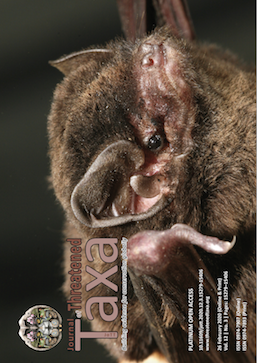Molecular detection of Murshidia linstowi in a free-ranging dead elephant calf
Main Article Content
Abstract
Gastrointestinal helminths are ubiquitous in both domestic and wild animals. Infections are often sub-clinical except in circumstances of destabilization of host-parasite equilibrium by innate or environmental factors. The present case deals with microscopic and molecular diagnosis of Murshidia linstowi recovered from an elephant. A post-mortem examination of a free-ranging juvenile male elephant calf that had died of electrocution in Athagarh Wildlife Division revealed the presence of slender, whitish nematodes in the stomach. No gross lesions were noticed either in the site of predilection or any other internal organs. The average length of the parasites was 3.8cm. These parasites were collected for further gross as well as microscopic examination following routine parasitological techniques. Temporary mounts prepared after cleaning the nematodes in lactophenol were observed under a microscope. Morphological features such as a well-developed mouth collar, large and globular buccal capsule with fine tubercles, cone shaped oesophageal funnel, short bursa having indistinctly divided lobes and closely apposed ventral rays and stout spicules with club shaped tips bent dorsally corroborated with that of M.linstowi (male). Amplification of the rDNA from the internal transcribed spacer (ITS) region using universal nematode primers NC2 and NC5 revealed a product size of 870bp. The PCR product was subjected to sequencing followed by NCBI-BLAST which revealed 98% homology with M. linstowi. A phylogenetic study showed a maximum similarity with M.linstowi recovered from elephants in Kenya. This particular nematode species belonging to the family Strongylidae and sub-family Cyathostominae appears to be the first documented report in India.
Article Details
Authors own the copyright to the articles published in JoTT. This is indicated explicitly in each publication. The authors grant permission to the publisher Wildlife Information Liaison Development (WILD) Society to publish the article in the Journal of Threatened Taxa. The authors recognize WILD as the original publisher, and to sell hard copies of the Journal and article to any buyer. JoTT is registered under the Creative Commons Attribution 4.0 International License (CC BY), which allows authors to retain copyright ownership. Under this license the authors allow anyone to download, cite, use the data, modify, reprint, copy and distribute provided the authors and source of publication are credited through appropriate citations (e.g., Son et al. (2016). Bats (Mammalia: Chiroptera) of the southeastern Truong Son Mountains, Quang Ngai Province, Vietnam. Journal of Threatened Taxa 8(7): 8953–8969. https://doi.org/10.11609/jott.2785.8.7.8953-8969). Users of the data do not require specific permission from the authors or the publisher.
References
Ajitkumar, G., K.S. Anil & P.C. Alex (2009). Healthcare management of Captive AsianElephants. Elephant Study Centre of Kerala Agricultural University, 94pp.
Altschul, S.F., W. Gish, W. Miller, E.W. Myers&D.J. Lipman (1990). Basic local alignment search tool. Journal of Molecular Biology 215: 403–410. https://doi.org/10.1016/S0022-2836(05)80360-2 DOI: https://doi.org/10.1016/S0022-2836(05)80360-2
Chandra, K., D. Gupta, K.C. Gopi, B.Tripathy&V. Kumar (2018).Faunal Diversity of Indian Himalaya. Zoological Survey of India, Kolkata, 105pp.
Edwards, S.J., M.W. Hood, J.H. Shaw, J.D. Rayburn, M.D. Kirby, D.T.Hanfman& J.A. Zidar (1978). Index-catalogue of medical and veterinary zoology, parasite-subject catalogue, parasites: Nematoda and Acanthocephala, Supplement 21, Part 4: 118.
Heinrich, L. (2016). Prevalence and molecular identification of helminthes in wild and captive Sri Lankan Elephants, Elephasmaximus. Research project-Royal Veterinary College. University of London.
Matsuo, K.&H. Supramah (1997). Some parasites from Sumatran elephants in Indonesia. Journal of the Helminthological Society of Washington 64: 298–299.
McLean, E.R., J.M. Kinsella, P. Chiyo, V.Obanda, C. Moss & E.A. Archie (2012). Genetic identification of five Strongyle nematode parasites in wild African Elephants(Loxondata Africana). Journal of Wildlife Diseases 48: 707–716. https://doi.org/10.7589/0090-3558-48.3.707 DOI: https://doi.org/10.7589/0090-3558-48.3.707
Muraleedharan, K. (2016).Endoparasites of Wildlife(Herbivores, Primates and Reptiles) of Karnataka state, India - an overview. Veterinary Research International 4: 89–98.
Nei, M. &S. Kumar(2000). Molecular Evolution and Phylogenetics. Oxford University Press, New York, 333pp.
Newton-Fisher, N.E., H. Notman, J.D. Paterson & V. Reynolds (2006).Primates of Western Uganda. Springer, New York, 516pp. https://doi.org/10.1007/978-0-387-33505-6 DOI: https://doi.org/10.1007/978-0-387-33505-6
Schwarz, G. (1978). Estimating the dimension of a model. Annals of Statistics 6: 461–464.
Singh, K.R.S. (2003). Veterinary Helminthology. Indian Council of agricultural Research, New Delhi, 347–348.
Tamura, K. (1992). Estimation of the number of nucleotide substitutions when there are strong transition-transversion and G+C content biases. Molecular Biology and Evolution 9(4): 678–687. https://doi.org/10.1093/oxfordjournals.molbev.a040752 DOI: https://doi.org/10.1093/oxfordjournals.molbev.a040752
Tamura, K. & M.Nei (1993).Estimation of the number of nucleotide substitutions in the control region of mitochondrial DNA in humans and chimpanzees. Molecular Biology and Evolution 10(3):512–526. https://doi.org/10.1093/oxfordjournals.molbev.a040023 DOI: https://doi.org/10.1093/oxfordjournals.molbev.a040023
Tamura, K., G. Stecher, D. Peterson, A.Filipski& S. Kumar (2013). MEGA6: Molecular Evolutionary Genetics Analysis version 6.0. Molecular Biology and Evolution 30: 2725–2729.
Tripathy,S.B., L.N.M. Acharjyo&N.K. Padhi (1991). Use of Fenbendazole against murshidiasis in zoo elephant.International Seminar on Veterinary Medicine in Wild and Captive Animals, 29pp.

